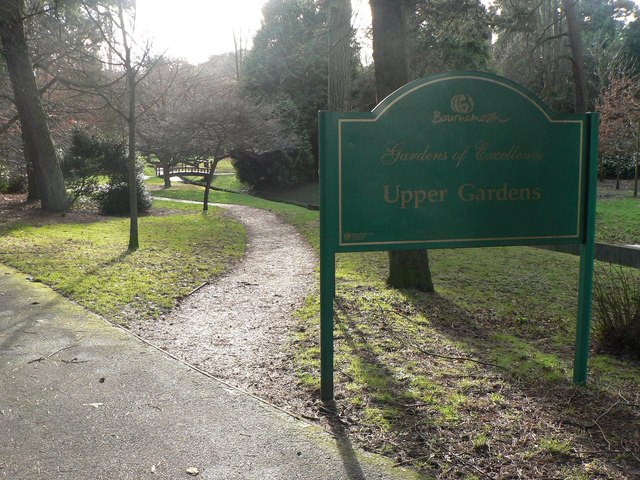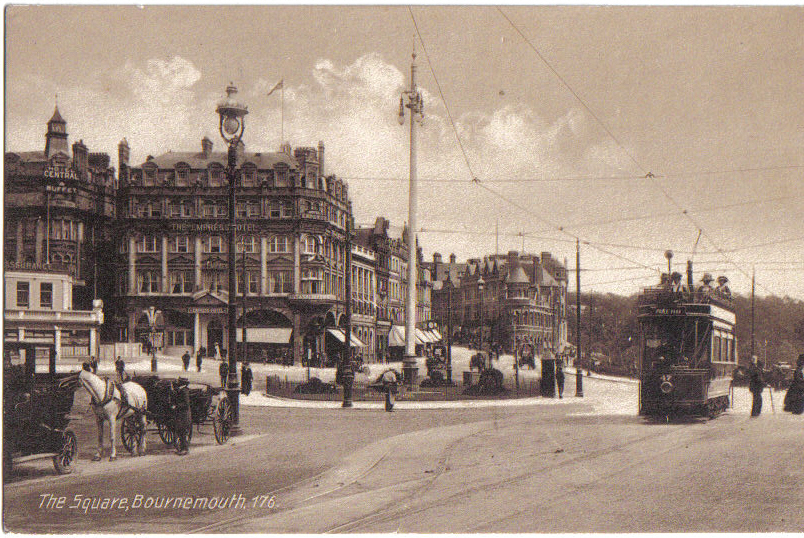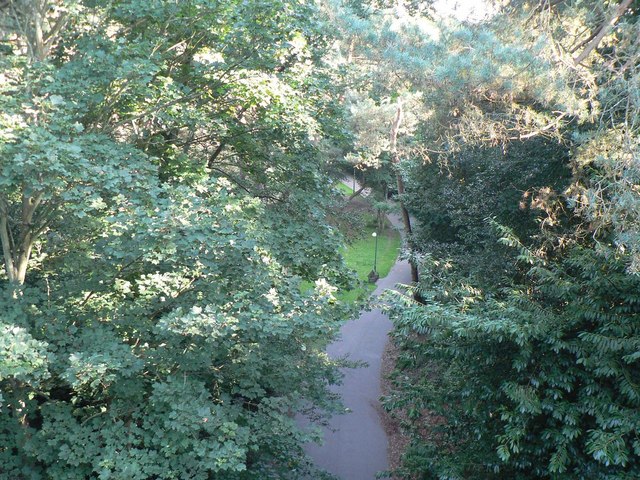|
Bournemouth Gardens, England
Bournemouth Gardens are Grade II listed gardens in the town of Bournemouth, Dorset, England. Created in the nineteenth century, the gardens follow the towns eponymous River Bourne three kilometres from the historic boundary with Poole south-eastwards into Bournemouth Town Centre. The Gardens are home to a number of significant Bournemouth landmarks and listed buildings such as; the Town Hall, the War Memorial, St. Andrew's Church and the Pavilion Theatre. Bournemouth Gardens have been Green Flag Award winners since 1999. History The gardens were planted between 1836 and 1840, with designs made by architects Benjamin Ferrey and Decimus Burton. It wasn't until 1859 that the gardens became publicly accessible. On 1 May 1908, 7 people were killed and 26 were injured when a tram crashed into the gardens. In 1924-29 the Pavilion Theatre was built in the Lower Central Gardens. In 1970 the Wessex Way flyover ( A338) was constructed, cutting through the Upper Central Gardens ... [...More Info...] [...Related Items...] OR: [Wikipedia] [Google] [Baidu] |
Mont Dore Hotel
Bournemouth Town Hall (formerly known as Mont Dore Hotel) is a municipal facility in Bourne Road, Bournemouth, England. The town hall, which is the meeting place of Bournemouth, Christchurch and Poole Council, is a Grade II listed building. The town hall stands opposite Bournemouth Gardens and the Bournemouth War Memorial and is adjacent to St. Andrew's Church, Richmond Hill. History The site had once formed part of a large wooded area known as "Bruce's Wood" named after the early 19th century owner of the land, Patrick Craufurd Bruce MP, who also planted vast forests in Berkshire, Gloucestershire, Oxfordshire and Hampshire. It was acquired by a solicitor, George Durrant, who renamed it the Branksome Estate, in the 1850s. Durrant started selling parts of the estate and the site was initially used for a boarding use known as The Glen. The site was then acquired by Dr Alfred Meadow who had ambitions to establish a spa hotel offering treatment for tuberculosis, bronchitis, asthma ... [...More Info...] [...Related Items...] OR: [Wikipedia] [Google] [Baidu] |
COVID-19 Pandemic In The United Kingdom
The COVID-19 pandemic in the United Kingdom is a part of the worldwide pandemic of coronavirus disease 2019 (COVID-19) caused by severe acute respiratory syndrome coronavirus 2 (SARS-CoV-2). In the United Kingdom, it has resulted in confirmed cases, and is associated with deaths. The virus began circulating in the country in early 2020, arriving primarily from travel elsewhere in Europe. Various sectors responded, with more widespread public health measures incrementally introduced from March 2020. The first wave was at the time one of the world's largest outbreaks. By mid-April the peak had been passed and restrictions were gradually eased. A second wave, with a new variant that originated in the UK becoming dominant, began in the autumn and peaked in mid-January 2021, and was deadlier than the first. The UK started a COVID-19 vaccination programme in early December 2020. Generalised restrictions were gradually lifted and were mostly ended by August 2021. A third wave, ... [...More Info...] [...Related Items...] OR: [Wikipedia] [Google] [Baidu] |
Grade II Listed Garden And Park Buildings
Grade most commonly refers to: * Grade (education), a measurement of a student's performance * Grade, the number of the year a student has reached in a given educational stage * Grade (slope), the steepness of a slope Grade or grading may also refer to: Music * Grade (music), a formally assessed level of profiency in a musical instrument * Grade (band), punk rock band * Grades (producer), British electronic dance music producer and DJ Science and technology Biology and medicine * Grading (tumors), a measure of the aggressiveness of a tumor in medicine * The Grading of Recommendations Assessment, Development and Evaluation (GRADE) approach * Evolutionary grade, a paraphyletic group of organisms Geology * Graded bedding, a description of the variation in grain size through a bed in a sedimentary rock * Metamorphic grade, an indicatation of the degree of metamorphism of rocks * Ore grade, a measure that describes the concentration of a valuable natural material in the surroun ... [...More Info...] [...Related Items...] OR: [Wikipedia] [Google] [Baidu] |
Victory In Europe Day
Victory in Europe Day is the day celebrating the formal acceptance by the Allies of World War II of Germany's unconditional surrender of its armed forces on Tuesday, 8 May 1945, marking the official end of World War II in Europe in the Eastern Front, with the last shots fired on the 11th. Russia and some former Soviet countries celebrate on 9 May. Several countries observe public holidays on the day each year, also called Victory Over Fascism Day, Liberation Day or Victory Day. In the UK it is often abbreviated to VE Day, or V-E Day in the US, a term which existed as early as September 1944, in anticipation of victory. The end of all combat actions was specified as 23:01 Central European Time, which was already 9 May in eastern Europe, and thus several former Soviet bloc countries including Russia and Belarus, as well as some former Yugoslav countries like Serbia, celebrate Victory Day on 9 May. History Adolf Hitler, the Nazi leader, had committed suicide on 30 April dur ... [...More Info...] [...Related Items...] OR: [Wikipedia] [Google] [Baidu] |
Chinese New Year
Chinese New Year is the festival that celebrates the beginning of a New Year, new year on the traditional lunisolar calendar, lunisolar and solar Chinese calendar. In Sinophone, Chinese and other East Asian cultures, the festival is commonly referred to as the Spring Festival () as the Spring (season), spring season in the lunisolar calendar traditionally starts with lichun, the first of the twenty-four solar terms which the festival celebrates around the time of the Chinese New Year. Marking the end of winter and the beginning of the spring season, observances traditionally take place from Chinese New Year's Eve, New Year’s Eve, the evening preceding the first day of the year to the Lantern Festival, held on the 15th day of the year. The first day of Chinese New Year begins on the new moon that appears between 21 January and 20 February. Chinese New Year is one of the most important holidays in Chinese culture, and has strongly influenced Lunar New Year celebrations of its 5 ... [...More Info...] [...Related Items...] OR: [Wikipedia] [Google] [Baidu] |
Bournemouth Eye
Bournemouth () is a coastal resort town in the Bournemouth, Christchurch and Poole council area of Dorset, England. At the 2011 census, the town had a population of 183,491, making it the largest town in Dorset. It is situated on the English south coast, equidistant () from Dorchester and Southampton. Bournemouth is part of the South East Dorset conurbation, which has a population of 465,000. Before it was founded in 1810 by Lewis Tregonwell, the area was a deserted heathland occasionally visited by fishermen and smugglers. Initially marketed as a health resort, the town received a boost when it appeared in Augustus Granville's 1841 book, ''The Spas of England''. Bournemouth's growth accelerated with the arrival of the railway, and it became a town in 1870. Part of the historic county of Hampshire, Bournemouth joined Dorset for administrative purposes following the reorganisation of local government in 1974. Through local government changes in 1997, the town began to be adm ... [...More Info...] [...Related Items...] OR: [Wikipedia] [Google] [Baidu] |
Christmas
Christmas is an annual festival commemorating Nativity of Jesus, the birth of Jesus, Jesus Christ, observed primarily on December 25 as a religious and cultural celebration among billions of people Observance of Christmas by country, around the world. A Calendar of saints, feast central to the Christian liturgical year, it is preceded by the season of Advent or the Nativity Fast and initiates the season of Christmastide, which historically in the West lasts Twelve Days of Christmas, twelve days and culminates on Twelfth Night (holiday), Twelfth Night. Christmas Day is a public holiday in List of holidays by country, many countries, is celebrated religiously by a majority of Christians, as well as Christian culture, culturally by many non-Christians, and forms an integral part of the Christmas and holiday season, holiday season organized around it. The traditional Christmas narrative recounted in the New Testament, known as the Nativity of Jesus, says that Jesus was born in Bet ... [...More Info...] [...Related Items...] OR: [Wikipedia] [Google] [Baidu] |
The Square, Bournemouth
The Square is a public square in Bournemouth Town Centre that marks the centre of Bournemouth, England. The Square separates the Central Gardens from the Lower Gardens. History In the 18th century Decoy Pond House stood at the point where a plank was used to cross the Bourne Steam on the track from Poole to Christchurch. The River Bourne still flows under the Square. In 1848 composer Hubert Parry was born next door to The Square and is marked with a blue plaque. In 1925, a tram shelter was built at the center of the Square, with a clock on the top, which was given by Captain HB Norton, a magistrate and former Councillor. The Square later became a large roundabout, with the clock being relocated into a clock tower at the roundabout's centre. By this time the clock tower had become known as the "Leaning Tower of Bournemouth". The roundabout was removed in October 1992, and since 2000 the square has been almost totally pedestrianised. The old clocktower is now the site of t ... [...More Info...] [...Related Items...] OR: [Wikipedia] [Google] [Baidu] |
Bournemouth Central Gardens - Geograph
Bournemouth () is a coastal resort town in the Bournemouth, Christchurch and Poole council area of Dorset, England. At the 2011 census, the town had a population of 183,491, making it the largest town in Dorset. It is situated on the English south coast, equidistant () from Dorchester and Southampton. Bournemouth is part of the South East Dorset conurbation, which has a population of 465,000. Before it was founded in 1810 by Lewis Tregonwell, the area was a deserted heathland occasionally visited by fishermen and smugglers. Initially marketed as a health resort, the town received a boost when it appeared in Augustus Granville's 1841 book, ''The Spas of England''. Bournemouth's growth accelerated with the arrival of the railway, and it became a town in 1870. Part of the historic county of Hampshire, Bournemouth joined Dorset for administrative purposes following the reorganisation of local government in 1974. Through local government changes in 1997, the town began to be ... [...More Info...] [...Related Items...] OR: [Wikipedia] [Google] [Baidu] |
Giant Redwood
''Sequoiadendron giganteum'' (giant sequoia; also known as giant redwood, Sierra redwood, Sierran redwood, California big tree, Wellingtonia or simply big treea nickname also used by John Muir) is the sole living species in the genus ''Sequoiadendron'', and one of three species of coniferous trees known as redwoods, classified in the family Cupressaceae in the subfamily Sequoioideae, together with ''Sequoia sempervirens'' (coast redwood) and ''Metasequoia glyptostroboides'' (dawn redwood). Giant sequoia specimens are the most massive trees on Earth. The common use of the name ''sequoia'' usually refers to ''Sequoiadendron giganteum'', which occurs naturally only in groves on the western slopes of the Sierra Nevada mountain range of California. The giant sequoia is listed as an endangered species by the IUCN, with fewer than 80,000 trees remaining. Since its last assessment as an endangered species in 2011, it was estimated that another 13–19% of the population (or 9,761–13,63 ... [...More Info...] [...Related Items...] OR: [Wikipedia] [Google] [Baidu] |
Bournemouth Gardens, Borough Boundary - Geograph
Bournemouth () is a coastal resort town in the Bournemouth, Christchurch and Poole council area of Dorset, England. At the 2011 census, the town had a population of 183,491, making it the largest town in Dorset. It is situated on the English south coast, equidistant () from Dorchester and Southampton. Bournemouth is part of the South East Dorset conurbation, which has a population of 465,000. Before it was founded in 1810 by Lewis Tregonwell, the area was a deserted heathland occasionally visited by fishermen and smugglers. Initially marketed as a health resort, the town received a boost when it appeared in Augustus Granville's 1841 book, ''The Spas of England''. Bournemouth's growth accelerated with the arrival of the railway, and it became a town in 1870. Part of the historic county of Hampshire, Bournemouth joined Dorset for administrative purposes following the reorganisation of local government in 1974. Through local government changes in 1997, the town began to be ... [...More Info...] [...Related Items...] OR: [Wikipedia] [Google] [Baidu] |
Westbourne, Dorset
Westbourne is an affluent residential and shopping area of Bournemouth, Dorset. It is located in between Branksome, Poole and the centre of Bournemouth, just off the A338. Poole Road, mainly full of specialised shops and small cafes, runs through the centre of Westbourne with Seamoor Road curving round bringing more shops and services. Many of the shops have residential property above them. Businesses and buildings The area has become a fashionable and popular part of Bournemouth with a unique mix of clothing shops, cafés, restaurants and many other independent businesses. Westbourne has a reputation for being the fashion district of Bournemouth, which is supported by the many boutiques and home interior shops located in the main shopping area. The main high street of Westbourne is centred around the grade II listed Victorian shopping arcade that links Poole Road and Seamoor Road. It was built in 1884-5 in a polychrome gothic style by the builder Henry Joy, who also built Bo ... [...More Info...] [...Related Items...] OR: [Wikipedia] [Google] [Baidu] |

.jpg)



.jpg)



